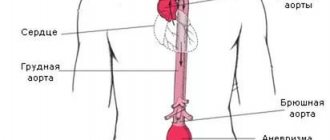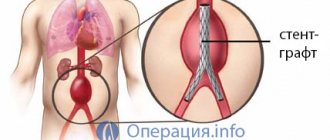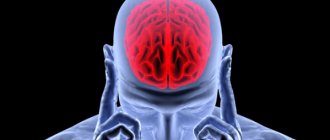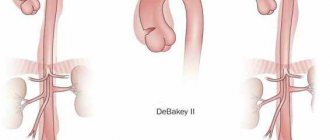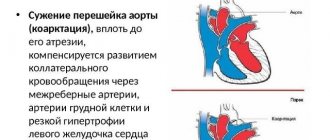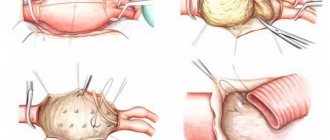The lower abdomen pulsates in women with gynecological diseases (inflammation of the appendages, suppuration of the ovary, rupture, cyst), and in men the cause may be the movement of a stone along the ureter, an inguinal hernia. Pain and throbbing in the umbilical region with a shift to the right and down is typical for appendicitis.
The feeling of a pulse beating in the abdomen in time with the contractions of the heart in men over 60 years of age, smokers and with high blood pressure requires urgent consultation with a doctor. This is important to rule out a very life-threatening abdominal aortic aneurysm. Diagnostics includes ultrasound, tomography, general tomography of the abdominal cavity. For aneurysm and tumor, suppuration, surgery is required; for other diseases, medications are most often used.
The stomach is pulsating: what does a person feel?
When complaining that the abdomen is throbbing, the patient can describe his sensations inside the abdominal cavity in the following words:
- stomach twitches;
- I feel a palpitation, a heartbeat near the navel;
- you can see how much your stomach is pulsating;
- there is a pulsation in the stomach;
- ticks, stomach pulsates in time with the heart;
- like a ball bouncing.
If such symptoms are present, the doctor asks clarifying questions about the time of onset, connection with food, physical activity, and whether the pulsation in the abdomen is constant or periodically appears and disappears. Then the patient reports on previous illnesses (history), after which an examination is carried out.
If the disease is serious, then patients usually describe the symptoms briefly; with functional and mental disorders (changes in the perception of sensations), the complaints are very numerous and completely varied, colorful.
What is the danger of an abdominal aortic aneurysm without surgery?
- Mortality after planned surgery is 0–0.34% per year in the long-term period.
- Mortality after operated rupture of an aneurysm in the first two months is 90%.
- Operative mortality varies greatly: for elective operations it is 7–10%;
- during operations for aneurysm rupture - 40 - 50%;
- for endoprosthetics – 1%.
The statistics presented and the experience of surgeons show that a planned operation is much preferable for the patient, since delay in the presence of indications for surgery is fraught with a threat to life. But even with careful preparation of the patient and assessment of surgical risks, the development of complications after surgery cannot be ruled out. They develop rarely and account for less than 4%.
This disease is fraught with the development of life-threatening complications, such as dissection, rupture or thrombosis of the aorta.
Why did the pulsation appear in the lower abdomen?
Pulsation in the lower abdomen can be associated with inflammatory diseases; in women, the cause is most often gynecological diseases:
- adnexitis (inflammation of the appendages), tubo-ovarian abscess (suppuration in the fallopian tube and ovarian tissue);
- ovarian cyst and its complicated course (pedicle torsion);
- adhesive disease of the abdominal cavity after cesarean section, removal of fibroids or other pelvic surgery;
- uterine prolapse;
- endometriosis;
- tumor processes in the uterus, appendages;
- ectopic pregnancy;
- rupture of the ovary (apoplexy), fallopian tube.
In men, the lower abdomen twitches and pulsates when a stone moves through the ureter, appendicitis, or inguinal hernia. When the abdomen pulsates in the lower part of a girl who is sexually active, it is necessary to conduct a pregnancy test. During pregnancy, pulsation is not dangerous, if there is no pain or bleeding; if they are detected, an urgent examination by a gynecologist is required, since such symptoms are typical for a miscarriage.
Treatment of acute pancreatitis
The main tasks in the treatment of acute pancreatitis are to resolve the causative factor that caused the disease, create functional rest of the pancreas, infusion therapy aimed at detoxification, elimination of hypovolemia, correction of metabolic disorders, as well as anti-inflammatory, symptomatic therapy, prevention of complications. The patient must be hospitalized in a hospital.
Read also Colon cancer - signs, diagnostic methods
General measures for acute pancreatitis include bed rest, diet - fasting in the first 1-3 days, then - table No. 5A according to Pevzner, cold on the stomach.
Infusion therapy is carried out with crystalloid solutions up to 5-6 liters per day or more under the control of central venous pressure, electrolytes and blood acid base. Antispasmodic therapy, improving the outflow of pancreatic juice and inflammatory secretions, helping to reduce intraductal pressure: no-spa, platifillin, spasmolin, glucose-novocaine mixture. Enzyme inhibitors. Insulin therapy for hyperglycemia. Antibiotics for the prevention and treatment of purulent complications of pancreatitis. Prevention of acute ulcers by prescribing proton pump blockers. Correction of existing diseases. In case of serious condition of the patient, symptoms of peritonitis, sepsis, multiple organ failure, treatment is carried out in the intensive care unit.
Pulsation in the abdomen: causes of sensations in different places
It is not always possible to immediately suspect a disease based on the location of the pulsation in the abdomen, since in most patients the localization of sensations changes; it is more important to take into account the accompanying symptoms.
In the area of the stomach, navel
The area of the stomach is the epigastric angle (epigastric zone); if strong pulsation appears between it and the navel, it is necessary to exclude the most dangerous cause - an abdominal aortic aneurysm.
This is a protrusion of its wall, which is often accompanied only by pulsation. Abdominal pain is often absent or tolerable, but attacks similar to radiculitis and exacerbation of inflammation of the pancreas are also possible.
Men over 60 years of age are more often affected, 2/3 of them are smokers. When the diagnosis is made late, the aortic wall becomes thinner, which can lead to rupture during physical stress or even at rest. Severe internal bleeding occurs because the aorta has the highest blood pressure. Most die.
The cause of aneurysm in 90% of cases is atherosclerosis, less often it develops with:
- aortoarteritis,
- syphilis,
- tuberculosis,
- rheumatism,
- mycoplasma infection,
- salmonellosis,
- abdominal trauma.
There is also a risk with congenital weakness of the aortic wall. Provoking factors can be arterial hypertension and cough in chronic lung diseases.
To the right of the navel
Pulsation to the right of the navel is most often associated with intestinal diseases, where the small intestine and the ascending part of the large intestine (colon) are located. If the place where the pulse is felt is closer to the groin area, then this may be one of the first symptoms of appendicitis.
Suspicion of its development is confirmed by:
- pain in the epigastric and periumbilical region;
- movement of pain downwards, closer to the groin;
- pain increases with coughing and laughing, decreases when lying on your side with bent knees;
- nausea, vomiting;
- temperature rise to 37.2-37.5 degrees;
- rapid pulse;
- constipation or diarrhea.
Painless forms of appendicitis with abdominal throbbing or twitching sensations are typical in elderly patients with diabetes.
To the left of the navel
To the left of the navel and in the upper third, pulsation is a sign of inflammation of the pancreas (pancreatitis), intestines (colitis), flatulence, and dysbacteriosis.
Also in this area, a pulse can be felt in case of an abdominal aortic aneurysm or a tumor neoplasm (benign and malignant). Signs indicating an intestinal tumor may include:
- rumbling in the stomach;
- alternating diarrhea and constipation;
- the appearance of blood in the stool or a dark, tarry appearance;
- painful urge to have a bowel movement;
- general weakness;
- loss of weight and appetite.
Above the navel
Pulsation and pain above the navel are possible with exacerbation of duodenal ulcer. It is usually associated with eating (30-40 minutes after), hunger pain and night pain are also typical. An important feature of this area is that an atypical form of myocardial infarction can occur with a sensation of pulse beating and squeezing.
Patients usually report severe weakness, nausea, vomiting, and diarrhea. The skin is pale and covered in cold sweat. The difference between a heart attack and diseases of the digestive system is that eating does not affect your well-being in any way, and when moving it becomes worse; rest alleviates the condition.
In the intestines
If a patient complains of pulsation in the entire abdomen or describes a feeling of beating of a vessel against the background of lack of air, interruptions in heart function, or strong causeless fear, then this is typical of a panic attack.
Its distinctive features:
- general condition is normal, it is possible to talk and move;
- chills alternate with hot flashes;
- feelings of unreality of what is happening;
- paroxysmal course, when between panic attacks the symptoms completely disappear.
In a supine position
In a state of complete rest, in a supine position, before going to bed, pulsation in the abdomen is often one of the manifestations of senesthopathy - psychological sensations without diseases. This condition is part of the symptoms of depression or hypochondria (constant concern about health), neurosis, and mental disorders.
Senestopathies are characterized by many different symptoms that do not fit within the course of any known disease. Patients describe their feelings as emotional and very painful. As it progresses, new symptoms are added all the time and/or the pulsation moves to other parts of the body.
During pregnancy, especially in the later stages, pulsation in a supine position is normal. It appears due to compression of the abdominal aorta and inferior vena cava by the enlarged uterus. In the third trimester, women are recommended to rest only on their side, so as not to disrupt blood circulation in the body.
What is a gastric aortic aneurysm?
If the body gives sudden signals, this indicates the development of pathological processes. Disturbances in the functioning of the gastrointestinal tract can manifest themselves as sensations of pulsation in the stomach area. The symptom is not a common complaint and appears less often than heartburn, pain, and nausea.
Description
When a sensation of pulsating fluttering in the stomach appears, an experienced specialist will take into account the clinical symptom. Pulsation in the area of the projection of the stomach signals the beginning of a pathological process with frequent manifestations.
The feeling of increased pulse in the abdominal muscle spreads to the anterior abdominal wall and brings discomfort to the person.
An increased pulse appears in serious pathological conditions of the abdominal wall organs, and in completely healthy people of all age categories.
Throbbing pain can vary in intensity - from mild discomfort to sharp pain. Normally, sensations of involuntary contraction occur if you remain in one position for a long time, especially an uncomfortable one. Intense physical activity and sports are provocateurs for the development of discomfort.
Nervous stress is often accompanied by spasms of the muscles of the gastric walls and peritoneum.
Changing positions will relieve tension from the muscles and reduce pressure from the abdominal wall.
To solve the problem, just change the uncomfortable position and lie on your side and relax. These actions will relieve tension from the muscles and reduce pressure from the abdominal wall.
If the measures brought a positive result, the pulsation passed without a trace, the condition is not a deviation or a symptom of a dangerous disease.
If the upper abdomen is constantly pulsating, the sensations gradually intensify and are accompanied by pain, nausea, you should definitely consult a doctor for advice.
The pulsation after exercise lasts longer, the sensations are localized in one place. But the condition is normal. You can make sure that this is not a consequence of pathology with a light massage of the abdominal muscles. If after these steps the sensations go away, consultation with a specialist is not required.
The stomach is pulsating in different places. Therefore, the pathology of a specific organ is determined by location. If the functioning of the main digestive organ is disrupted, the pulse of the abdominal muscle is felt to the left, just above the navel.
Disorders of this organ and intestines are manifested by pulsations in the middle part of the abdomen. This location corresponds to pathological vasodilation, which is characteristic of aortic aneurysms.
The pathological condition of the pancreas and its ducts is determined by vibrations in the peri-umbilical area on the right.
Causes of pulsation in the stomach
Gastric pulsation occurs with the development of many gastrointestinal diseases. But it is possible for a symptom to appear due to third-party pathologies that irradiate to the area of the projection of the stomach. Pulsation appears more often after eating and is accompanied by pain. The pain can be sharp, shooting, periodic, constant, aching. Often the reasons are physiological in nature. Provoking factors:
- Gastritis in acute or chronic aggravated condition.
- Tumor processes. Often, the presence of an increased pulse at the top of the anterior abdominal wall allows one to suspect cancer.
- Vascular changes. When the aorta narrows, which is often accompanied by atherosclerosis, the pressure inside the vessel increases, the blood flow is turbulent with an increase in pulse. In this case, the walls of the vessel gradually lose their elasticity, which prevents them from maintaining normal blood flow pressure. As a result, the person begins to feel a strong pulse.
- Formed aneurysm of the main vessel - the aorta. It is located in the retroperitoneal space. An aneurysm is characterized by persistent expansion with stretching of the aortic walls in one area. This happens due to morphological and functional changes in the walls. Aneurysms come in different shapes and sizes, most often sac-shaped or fusiform. In this case, the age group of patients is 60 years and older. The aneurysm manifests itself as a pulsation in the middle part of the abdomen. Additionally, with an aneurysm, pain, belching, and bloating appear. The patient begins to lose weight.
- Reduction in the diameter of the abdominal aorta without the formation of an aneurysm. The reason is the hardening of the walls of the aorta, which causes plaques to appear and pressure inside the blood vessels to increase. When blood flows through a constricted area under pressure, there is resistance to its flow. Therefore, pulsation of the peritoneum occurs.
- Pancreatitis. Usually, an increased pulse in the upper part of the abdominal wall is accompanied by severe girdle pain, heaviness, and a change in the state of ulcers during bowel movements.
- Liver pathologies. The organ may pulsate with visible enlargement, with the development of cirrhosis, hepatitis, and cholestasis.
- Dysfunction of the heart muscle. The upper abdomen pulsates with persistent diffuse expansion or thickening of the wall of the right ventricle of the heart, which is located above the xiphoid process. Increased fluttering is felt in the epigastric region.
- Mental disorders, central nervous system dysfunctions. Constant exposure to stress and psycho-emotional stress negatively affects the body, causing many pathological processes.
When overeating, the stomach works intensively, which causes pulsation.
In other cases, the reasons are physiological:
- Thin and tall. People of the asthenic type often feel a strong pulse in the upper abdomen due to the proximity of the aorta. This phenomenon is considered normal.
- Prolonged stay in an uncomfortable position, physical activity with muscle strain. The symptom is relieved by rest and light massage.
- Binge eating. Excess food in the stomach cavity causes the organ to work intensively, which causes pulsation.
- Hiccups. During shudders and sudden contractions of the diaphragm, sensations can be transmitted to the epigastric region.
- Early pregnancy. During this period, strong changes occur in all organs and systems of the body, especially in the blood vessels. Therefore, pulsation can accompany a pregnant woman until delivery. But in most cases, the reason lies in hiccups and slight movements of the fetal limbs.
Sometimes it pulsates in the upper part of the peritoneum in the morning on an empty stomach. This may be caused by spasms of the diaphragm, which is similar in mechanism to hiccups. The etiology of the condition is explained by the reflux of stomach acid into the esophagus passing through the diaphragm.
The process is aggravated by the horizontal position. When a person wakes up and begins to move, the tissues irritated by the acid contract. The duration of the sensation depends on the time of exposure to the stimulus.
Often the process is accompanied by heartburn or regurgitation.
Pulsating sensations occur due to cardiac arrhythmia when body position changes during sleep. If pressure is applied to the heart area, the pulsation can last several minutes and radiate to the epigastric zone.
Measures to improve the condition
- With pulsating movements in the upper abdomen, there is no need to panic.
- You need to determine where it hurts and localize the sensations.
- The nature of the pulsation is set: constant, periodic.
- The strength of the pulsation is determined.
- You should check the variability of pulsation when changing body position, while eating, or when changing the amount of food or liquid consumed.
- Do you need to determine whether the peritoneum hurts when pulsating or not? If the answer is positive, the strength, character, and rhythm of the pain syndrome are assessed.
- If the pain is sharp and prolonged or there are already pathologies in the stomach and other internal organs, you need to consult a specialist.
- If you have morning pulsations in the upper abdomen, it is recommended to take a medicine at night that makes it difficult for stomach acid to flow into the esophagus, for example, Gaviscon.
- Pulsation in aortic aneurysm is eliminated by symptomatic treatment. Conservative therapy in this case is possible until the vessel walls rupture. A rupture of the aorta due to an aneurysm is repaired surgically. The prognosis for aortic aneurysm is poor.
To establish the etiological factors for the appearance of constant pulsation with pain of varying strength and sensations, it is recommended to undergo a diagnostic examination. Today the following are widely used:
- ultrasound diagnostics;
- CT scan;
- X-ray examination.
These methods allow you to obtain comprehensive data on the patient’s health status and make an accurate diagnosis.
Instrumental examination of the abdominal cavity makes it possible to choose the correct course of treatment for the underlying pathology.
With the primary manifestation of flutter in the epigastric region, that is, in an isolated case in a person without known pathologies of the gastrointestinal tract and other organs, the symptom does not pose a threat.
It is possible to use light sedatives to calm the patient, since pulsations often occur against the background of nervous overstrain or overexcitation. In this case, the stomach does not hurt, there is only discomfort after eating or physical activity. If pulsation in the stomach area recurs or persists, consultation with a therapist and gastroenterologist is required.
Prevention
The list of preventive measures depends on the etiological factors:
- With physiological provoking parameters, regular rest, nutritional control, and reduced physical activity are sufficient. Stressful situations and severe nervous tension should be avoided.
- If you have high acidity, it is recommended to take medications that reduce the secretion of gastric acid, such as Gastal. Espumisan is prescribed in the complex to reduce bloating.
- For digestive disorders, Creon is prescribed.
An effective preventive measure is a moderate diet with the temporary exclusion of fried, spicy, and fatty foods. Poor nutrition can cause discomfort such as pain in the upper abdomen.
Source: https://TvoyZheludok.ru/bolezni/pulsiruet-zheludok.html
How is a pulse in the abdomen diagnosed?
Since the sensation of a pulse in the abdomen can be both completely harmless and life-threatening, it is important to undergo an examination if there is frequent or constant pulsation. The doctor conducts an examination, palpates the abdomen and listens to the abdominal aorta with a stethoscope. Asks the patient whether his blood relatives had similar symptoms.
Instrumental diagnostics include:
- plain radiography of the abdominal cavity;
- Ultrasound and duplex scanning of the abdominal aorta;
- tomography (computer, multispiral, with angiography);
- aortography (filling a vessel with a contrast agent);
- intravenous urography (study of contrast removal by the kidneys).
If these methods do not provide the necessary information for diagnosis, then women need an examination by a gynecologist, men are advised by a urologist, and regardless of gender, examination by a nephrologist or psychiatrist may be required.
Diagnosis of acute pancreatitis
Based on the patient’s complaints, medical history, clinical picture (symptoms).
Laboratory diagnostics. Complete blood count: leukocytosis with neutrophilic shift, accelerated ESR. In a biochemical blood test: increased levels of amylase, C-reactive protein, electrolyte disturbances, increased blood glucose, with jaundice increased bilirubin, alkaline phosphatase. A general urinalysis reveals the appearance of diastase; with a significant insulin deficiency, glucosuria (glucose in the urine).
Instrumental diagnostics. The main method for diagnosing acute pancreatitis is ultrasound examination (ultrasound), which reveals an increase in size, decreased echogenicity and blurred contours of the pancreas, the presence of abscesses and cysts, dilation of the pancreatic ducts and common bile duct, the presence of stones in the gallbladder, ducts, and the area of the Vater nipple. Magnetic resonance and computed tomography are very informative in acute pancreatitis. Additional research methods are chest x-ray and endoscopy.
If there is a strong pulsation in the abdomen, do you need to see a doctor urgently?
If there is strong pulsation in the abdomen, it is imperative to consult a doctor. If there is no pain and the general condition is normal (no weakness, pale skin), then you can come to the clinic for an appointment. You can start the examination with a therapist; he will prescribe primary diagnostic methods and refer, if necessary, to other specialists.
If there is pain and throbbing in the abdomen, immediately call an ambulance, as this combination is dangerous due to the development of an acute inflammatory process and rupture of a previously undetected abdominal aortic aneurysm.
Causes of aneurysm
- Atherosclerosis, characterized by the appearance of fatty plaques on the vascular walls of the aorta and its branches. The influence of atherosclerosis on the course of an aneurysm has not been fully studied, but the relationship between atherosclerosis and circulatory disorders and, as a consequence, cessation of the delivery of nutrients to the abdominal organs has been proven.
- Diabetes mellitus affecting the blood arteries. There are often cases when it is accompanied by nephropathy and retinopathy.
- Genetics. There are several congenital syndromes, for example, Ehlers-Danlos syndrome, Marfan syndrome, etc. They affect the abdominal aorta. In most cases, there is a relationship between the aneurysm and hereditary diseases.
- Infectious diseases. These are ailments that affect the heart, syphilis, salmonellosis and others.
- Abdominal injuries. So, with a strong blow to the chest or stomach, the aorta may be damaged.
- Inflammatory processes that can cause thinning of the walls of the aorta.
What treatment can there be if there is throbbing abdominal pain?
Pulsating abdominal pain due to an abdominal aortic aneurysm necessarily requires surgery. Treatment before complications develop is through small incisions in the thigh. A metal frame (stent-graft) is inserted, which supports the walls of the aorta and isolates the aneurysmal sac from the blood flow, which prevents rupture of the aneurysm. This type of operation is less traumatic and there are rarely complications.
If it is not possible to perform stenting, then a part of the aorta with expansion is removed through an incision in the abdominal wall and a prosthesis is placed in its place. In the event of a tear or rupture, surgery is performed for emergency reasons to save life. You cannot refuse surgical treatment for large aneurysms (diameter 5 cm or more), since 75% of them rupture, and half of the patients cannot be helped.
For diseases of the stomach and intestines with pain and pulsation, enzymes (Creon, Festal), antispasmodics (No-shpa, Buscopan), anti-bloating drugs (Espumizan, Meteospasmil) are used. For dysbiosis, probiotics are used (Lactofiltrum, Linex). To improve digestion, herbs are indicated: tea from mint, chamomile, flax seeds.
For neurosis and senesthopathy, psychotherapy sessions are indicated. For functional mental disorders, plant-based sedatives are used (Persen, Novo-passit, valerian extract), Glycine. Patients with gynecological diseases are prescribed antibiotics, anti-inflammatory and absorbent drugs, but surgery may also be required. Once a tumor is detected, it must be removed.
Aortic pathologies
First of all, elderly people are susceptible to aortic pathologies, and women to a lesser extent than men. The development of pathology is a rather long process. Sometimes the pathology develops so slowly that for many years it does not bother a person at all; he leads a normal lifestyle. Often in old age, calcification of the aorta can be observed.
There is a classification of aortic aneurysm. Classified according to the following criteria:
Let us consider in more detail the classification of aortic pathology according to these characteristics.
Types of aneurysm by segment:
- Sinuses of Valsalva;
- Aortic arches;
- Aneurysm of the ascending division;
- Descending aneurysm.
It is worth noting that an aneurysm can be combined, that is, combine several types of pathologies. In this case, the doctor must prescribe step-by-step treatment. First of all, attention is paid to the more affected area, and, secondly, the less painful area of the abdominal aorta is healed.
Based on etiology they distinguish:
- True. In this case, the membrane becomes thinner and a protrusion appears on it. Such cases are not uncommon with syphilis, atherosclerosis of the abdominal aorta and diseases of a similar type.
- False. A false aneurysm may appear if the abdominal aorta has been injured, or may result from surgery. This is not an indicator of an incorrectly performed operation, it is one of the possible complications.
Classification by shape:
- Saccular. There is bulging of the walls outward in several places.
- Fusiform. The same thing happens, but throughout the entire aorta, and not in individual areas.
Classification depending on the course of the disease:
- Uncomplicated.
- Delaminate.
- With complications.
The most serious of these pathologies is complicated. Often the result of this disease can be rupture of the aortic sac. Signs of a complicated aneurysm:
- Hematomas.
- Thromboembolism.
- Internal bleeding, which can result in death due to blood loss.
Unfortunately, statistics provide disappointing results - in most cases, the patient dies if there are no medical workers nearby.
Measures to prevent the feeling of pulsation in the abdomen
To avoid sensations of pulsation in the abdomen, it is recommended:
- a diet with a sufficient amount of plant foods (boiled vegetables, cereals), lean protein (fish, chicken, cottage cheese), fermented milk drinks;
- frequent meals, in fractional quantities;
- sleep at least 8 hours a night;
- avoid stressful conditions;
- stop smoking and drinking alcohol;
- daily do therapeutic exercises or sports with a dosed load on the muscles of the anterior abdominal wall (after excluding an aneurysm);
- walk in the fresh air for at least an hour 4-5 times a day;
- promptly treat diseases of the digestive system and other chronic diseases;
- monitor blood pressure, sugar and cholesterol levels, take medications to normalize them, reduce the intake of salt, sweets, flour and fats of animal origin;
- do not try to get rid of the symptoms of pain and throbbing on your own;
- undergo preventive examinations for familial abdominal artery aneurysm.
The abdomen pulsates with an abdominal aortic aneurysm, diseases of the intestines, genitourinary system, and neurosis. Periodic beating of the pulse in the abdominal cavity without pain and other symptoms is often not dangerous, but examination is necessary, since some patients require urgent or planned surgery.
Forecast and prevention of the disease
In modern medicine, dissecting aneurysm is considered a rather unpredictable disease that can lead to death. Thanks to modern technologies, there are now many ways not only to diagnose abdominal aortic aneurysm, but also to treat it.
In order to prevent aneurysm dissection, the necessary examination should be constantly carried out.
First of all, it is recommended to give up bad habits, as well as reconsider your future work and rest regime. Preventive measures imply compliance with certain rules and recommendations:
- refraining from excessive physical activity, as this can prevent possible rupture of an abdominal aortic aneurysm;
- maintaining proper nutrition and diet, especially for foods that can cause gas;
- carefully monitor blood pressure levels and, if necessary, use medications that can bring the levels back to normal.
Compliance with the above rules can help prepare the patient’s body for the upcoming surgical treatment, which in turn will increase the chances of a complete recovery even in the case when the aneurysm is already dissecting and rupture of the abdominal aortic aneurysm is inevitable.
For timely detection of abdominal aortic aneurysm, patients suffering from atherosclerosis or having a history of this vascular pathology are recommended to undergo systematic medical observation with periodic instrumental examination (radiography of the abdominal cavity, ultrasound).
Quitting smoking and active treatment of infectious and systemic inflammatory diseases are of no small importance in the prevention of aneurysm formation.
www.neboleem.net
Abdominal aortic aneurysm is an insidious and unpredictable vascular pathology. The probability of death from a ruptured large aneurysm is more than 75%. Moreover, from 30 to 50% of patients die in the prehospital stage.
In recent years, cardiac surgery has seen significant progress in the diagnosis and treatment of abdominal aortic aneurysm: the number of diagnostic errors has decreased, and the number of patients subject to surgical treatment has expanded. First of all, this is due to the use of modern imaging studies and the introduction into practice of endoprosthetics of aortic aneurysm.
To prevent the potential threat of abdominal aortic aneurysm, persons suffering from atherosclerosis or having a family history of this disease should undergo regular examinations.
Quitting unhealthy habits (smoking) plays an important role. Patients who have undergone surgery for an abdominal aortic aneurysm need to be monitored by a vascular surgeon and undergo regular ultrasound and CT scans.
